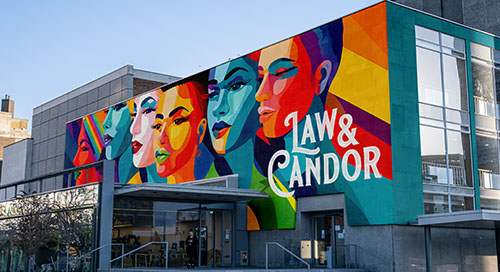
Inspiring Inclusion to Foster Innovation and Shape the Future of Legal
March 8, 2024
|
By:
This year’s International Women’s Day theme is “Inspire Inclusion.” The theme asks us to celebrate women’s achievement while challenging us to imagine a world where every difference is valued.
In honor of International Women’s Day, Lighthouse invited four women leaders in the legal space to share their perspectives on the topic with women leaders at Lighthouse. Throughout Women’s History Month, Lighthouse will feature the following conversations in a series, In Conversation: Women Shaping the Future of Legal:
- Ava Guo, Assistant Vice President, and Senior Legal Counsel at AT&T, in conversation with Gina Willis, Associate Director of AI & Analytics at Lighthouse
- Irene Fiorentinos, Of Counsel at Jones Day, in conversation with Amanda Jones, Director of Search and Information Retrieval at Lighthouse
- Sadie Khodorkovsky, Global Head of Legal Discovery at JPMorgan Chase, in conversation with Dawn Garrison, Senior Proposal Manager at Lighthouse
- Sarah Sawvell, Director of Legal Operations and eDiscovery at Honeywell, in conversation with Kamika Brown, Associate Director of Client Services at Lighthouse
These leaders shared perspectives on inclusivity—including its importance to innovation, how to foster it within organizations and law firms, and how to lead the next generation of young women in the industry.
From these conversations, five common themes emerged:
1. Diversity, equity, and inclusion are three equally important, but separate ideas
2. Inclusion fuels innovation
3. We all have a duty to intentionally challenge bias and stereotypes
4. Women should not be afraid to speak up and recognize our own achievements
5. To help the next generation of women in legal, we must lead by example

Diversity, equity, and inclusion are three equally important, but separate ideas
There’s no question that most large corporations, law firms, and service providers have heightened their focus on diversity, equity, and inclusion (DE&I) over the last few years. However, the three terms often get lumped together as a singular idea—often centered on achieving diversity within the organization. It is important to recognize that each term is a separate, but equally important, idea and goal. As Irene Fiorentinos shared:
“To me, inclusion is in some ways the next step after diversity and equity. We created diverse teams or organizations, we tried to be equitable in how we treat people—but we can't just stop there.”
Both the legal and technology industries have historically been male dominated. Inclusion is vital to ensure that women are not only represented and have equal opportunities, but that their unique viewpoints and voices are included, championed, and celebrated in the same way as their male counterparts. On this point, Sarah Sawvell explained:
“Each one of us has unique and special talents to offer our professional and personal communities. Fostering an inclusive environment of mutual respect and understanding allows individuals to fully highlight these attributes and showcase their abilities.”
Inclusion fuels innovation
The goal of inclusion is not just a goal for its own sake. An inclusive organization ensures that the best ideas are being brought to the table for consideration. As such, inclusivity will play an increasingly critical role as novel technology—like generative AI—causes disruption across almost every industry. Companies and law firms alike are seeking innovative ways to harness AI, while legal and compliance teams grapple with managing downstream disruptions and potential risks. Those challenges will require a diverse and innovative set of skills, knowledge, and new ideas.
Indeed, the most innovative teams and organizations are, by nature, diverse—with people from different backgrounds and experiences coming together to look at a problem from various angles and perspectives. They are also inclusive, with the best ideas being championed without bias or stereotypes. These concepts are backed by statistics. Studies show that more diverse and inclusive organizations are 1.7 times more innovative.
In her conversation, Sadie Khodorkovsky explained:
“Inclusivity broadens your knowledge of the world around you. If you’re someone who is looking to innovate and change things, your ceiling of opportunity to do that is going to be much higher the more expansive your network is.”
Organizations that welcome, include, and champion diverse voices are also better at attracting and retaining top talent—a foundation of innovation. Statistics show that 1 in 3 employees and job seekers would not apply to a job at a company where there is a lack of diversity. Innovative and talented job seekers want to work in a place where they feel welcome and included for who they are, and where different perspectives are valued.
Ava Guo, Irene Fiorentinos, and Sarah Sawvell each asserted the important role inclusion plays in keeping and retaining innovative leaders in the legal and technology fields.
Ava noted:
“Inclusion seems very basic and fundamental to just bringing the best out of all your employees. And without that as sort of a bedrock principle, in this day and age, I don't really know how you get anywhere.”
Irene echoed that idea, explaining:
“I cannot practice law by myself sitting in my office. There has to be a team. And to me, it's important that we make it possible for that team to have a variety of experiences and a diversity of knowledge.”
Similarly, Sarah noted:
“There is a lot we can learn from one another. It is critical that we create safe and secure environments to enhance and support these interactions.”
We all have a duty to intentionally challenge bias and stereotypes
Allies have a responsibility to challenge stereotypes and inherent biases, which are often the biggest hurdles to fostering an inclusive environment. For women in the legal and technology space, that can mean fighting against the perception that there are not as many women experts in law or technology because women are less competent in those areas—a perception that is both factually and historically inaccurate.
Sadie Khodorkovsky cautioned that everyone must “stay mindful that perception and stereotypes are not necessarily reality.” She noted:
“Everybody is an ally to somebody. So, it’s important to always be aware of what our own biases are and open doors for people who may not have the same opportunities we have.”
She continued by explaining that to foster an environment where the best ideas have equal footing, we all share a duty to proactively notice when biases may hinder inclusivity:
“We must ensure that the smartest, most experienced people are being invited to the conversation, irrespective of stereotypes or bias—both unconscious and conscious. When there is too much commonality in a room, it's incumbent on our allies and ourselves to notice and question it. Did we invite everyone that we should be inviting to this meeting or presentation? Are we always calling on the same people just because we're comfortable with each other? Are we not thinking to include others because we've historically never worked with that person or group? We should really be challenging these assumptions and comfort levels.”
Ava Guo made this point as well, explaining that for her, that starts by challenging her own biases:
“One of the biggest things that you can do to address biases is to look at your own biases. I find myself checking my own prejudices and preconceived notions about people all the time just based on my background—whether that's about other women, about men, about whoever it is that I'm interacting with. The first step, if I form an opinion, is to ask: What is that based on? And why do I think that?”
Women should not be afraid to speak up and recognize our own achievements
Another important step in fostering a more inclusive environment is to create space for women to speak up and recognize our own achievements and accomplishments. As Ava Guo put it:
“Outwardly, one of the most important things that we, as women in this industry, can do is speak up.”
Irene Fiorentinos shared this point too, explaining that speaking up intentionally about our own accomplishments can help challenge the historical stereotypes and biases against women:
“When I first started practicing, I don’t want to say I was the “one and only,” but I was clearly one of a few. Whether it was in the courtroom, deposition, meeting, or office, I was one of a few. And now I'm no longer one of a few. I am one of many. But I think it's still important to say out loud, “Look at us.”
Sarah Sawvell expressed a similar thought:
“Sharing the history, stories, and information about overcoming challenges and barriers is key to preparing and inspiring the next generation of female leaders. If we take the time to talk about and learn about the efforts, (both successful and unsuccessful) of previous generations, there are many lessons that can be applied today to further develop more inclusive environments.”
Irene Fiorentinos explained that when women leaders purposely and explicitly take stock in our accomplishments and recognize how far we’ve come, it helps create space for the next generation of women:
“I do believe that if you have spent a long time at your job and have become senior and successful within your organization, it means that you worked really hard in every aspect of your life. It did not happen by chance. I think it's important to say to those that have gotten to a senior level, and those that are trying to get to a senior level, “Look, it works, it happens.”
To help the next generation of women in legal, we must lead by example
By reflecting on how we got to where we are now, we can see the work we must do for the next generation of women leaders in legal and technology.
Sadie Khodorkovsky remarked on how her career path has been paved, in part, by people who were confident enough to allow her to lead:
“It takes self-confidence to create an environment where somebody else can step up and lead. I am thankful to have had people in my life who have created those types of scenarios for me.”
Sarah Sawvell also looked back on the work previous generations did to help women succeed:
“Early in my career, in my hometown of Columbia, South Carolina, there were several trailblazers who broke down barriers, demonstrated what was possible, and served as role models for me and for so many other young professionals in the legal community. Without their leadership, advocacy, and advice, my career and life would look much different than it does today.”
By looking at the work done by previous generations, it becomes clear that women today must similarly lead by example and purposefully set out a path for the next generation of women to follow.
Ava Guo explained it this way:
“Set an example. Be what you want others to be. If you want a group of your direct reports, or a group of people you're working with, to be open and to be their authentic selves, then you should present yourself that way. Don't be afraid to share your own experiences. Don't be afraid to be you. Don't be afraid to make mistakes and own them.”
Sarah Sawvell reiterated this idea, stating that it was incumbent on women leaders to step up and act as mentors and advisors to the next generation of women.
“International Women’s Day, Women’s History Month, and professional organizations like Women in eDiscovery (WiE) or employee resource groups (ERGs) are safe forums to start and have these conversations. But they should not end here. Finding and serving as a trusted mentor and advisor to others is a critical component to fostering the next generation of leaders.”
Conclusion
While both the legal and technology industries have come a long way in terms of diversity, equity, and inclusion, it is imperative that we continue to focus on all three aspects—both at an organizational level and as individuals. That focus will not only help create new opportunities for women but will also fuel innovation in a rapidly evolving industry.






